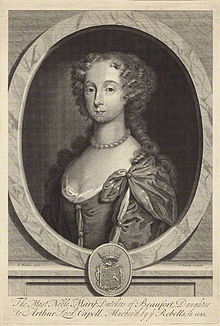Mary Somerset, Duchess of Beaufort (gardener)
Mary Somerset, Duchess of Beaufort (baptised 16 December 1630 – 7 January 1715)[1] also known by her other married name of Mary Seymour, Lady Beauchamp and her maiden name Mary Capell, was an English noblewoman, gardener and botanist.[2]

Biography
Mary was born in Hadham Parva, Hertfordshire, England sometime before 16 December 1630, on which date she was baptised. She was the daughter of Sir Arthur Capell, 1st Baron Capell of Hadham and Elizabeth Morrison.[1]
On 28 June 1648, Mary married her first husband Henry Seymour, Lord Beauchamp, and they had one son and one daughter. Her husband was a Royalist, imprisoned during the English Civil War. Her second husband, whom she married on 17 August 1657 was Henry Somerset, who became 1st Duke of Beaufort, by whom she had six children.[1]
During the Popish Plot, she was required in her husband's absence to call out the militia, to deal with a false alarm of a French invasion. In general she maintained a detached attitude to the Plot, expressing her amazement that the informer William Bedloe, whom she knew to be " a villain whose word would not have been taken at sixpence", should be given "power to ruin any man".
Widowed in 1699/1700, she died on 7 January 1715 in Chelsea, London, England at the age of 84. She was buried at St Michael and All Angels Church in Badminton, Gloucestershire. Her many descendants included Diana, Princess of Wales, and the Dukes of Beaufort.
Botanist and gardener
The Duchess of Beaufort was one of Britain's earliest distinguished lady gardeners, Alice Coats observes.[3] She began seriously to collect plants in the 1690s,[4] and her interest in gardening intensified in her widowhood.[5] She had the assistance of such well-known gardeners and botanists as George London and Leonard Plukenet; seeds came to her from the West Indies, South Africa, India, Sri Lanka, China and Japan.[6] In 1702 she engaged the services of William Sherard as tutor for her grandson, "hee loving my diversion so well. Sherard introduced more than 1500 plants, most of them greenhouse subjects, to her collection, at Badminton House or at Beaufort House, Chelsea. Her London house was next to that of Sir Hans Sloane, making her a neighbour of the Chelsea Physic Garden.[7] Her herbarium, in twelve volumes, 'gathered and dried by order of Mary Duchess of Beaufort',[8] she bequeathed to Sir Hans Sloane, by whose bequest it came to the Natural History Museum.[9] Her two-volume florilegium of drawings by Everhardus Lychicus of her most choice exotics remains in the library at Badminton.[10] Among her introductions to British gardening, most of which were greenhouse plants, are Pelargonium zonale one of the parents of the zonal pelargoniums of gardens, ageratum and the Blue Passion Flower (Passiflora caerulea).[11] The genus Beaufortia, erected in the 19th century by Robert Brown to describe some Myrtaceous plants of Southwest Australia, commemorates her.
Her portrait was painted by Sir Godfrey Kneller in 1708. Sir Peter Lely's portrait of the Duchess with the Countess of Carnarvon is at the Metropolitan Museum of Art.
Family
Children with Henry Seymour, Lord Beauchamp:
- William Seymour, 3rd Duke of Somerset (d. 12 Dec 1671)
- Lady Elizabeth Seymour (c.1655-12 Jan 1697) married Thomas Bruce, 2nd Earl of Ailesbury
Children with Henry Somerset, 1st Duke of Beaufort:
- Henry Somerset, Lord Herbert (bef 1660, died as infant)
- Charles Somerset, Marquess of Worcester (Dec 1660-13 Jul 1698)(who had a military and political career).
- Lord Arthur Somerset (c.1661-?)
- unknown daughter Seymour (bef 1663-?)
- Lady Mary Somerset (1664-19 Nov 1733) married James Butler, 2nd Duke of Ormonde
- Lady Henrietta Somerset (c.1670-10 Aug 1715) married firstly Lord Ilbracken, son of Henry O'Brien, 7th Earl of Thomond and secondly Henry Howard, 6th Earl of Suffolk
- Lady Anne Somerset (22 Jul 1673-17 Feb 1763) married Thomas Coventry, 2nd Earl of Coventry
References
- ^ a b c "Mary Capell". ThePeerage.com. Retrieved 5 July 2010.
- ^ Kell, P. E. "Somerset, Mary, duchess of Beaufort". Oxford Dictionary of National Biography (online ed.). Oxford University Press. doi:10.1093/ref:odnb/40544. (Subscription or UK public library membership required.)
- ^ Coats, Garden Shrubs and Their Histories (1964) 1992:212 (brief notice of her gardening abilities).
- ^ Douglas Chambers, "'Storys of Plants': The assembling of Mary Capel Somerset's botanical collection at Badminton" Journal of the History of Collections, 1997
- ^ Alice Coats remarks that "she would probably have been greatly annoyed had she known that Aiton was to date the year of her introductions from the date of her husband's death, not of her own." (Coats (1964) 1992:212); Aiton's work was Hortus Kewensis.
- ^ Chambers 1997.
- ^ Noted by R Stungo, "Recording the Aloes at Chelsea. A Singular Solution to a Difficult Problem" Notes and Records of the Royal Society of London, 1996.
- ^ Paul A. Fryxell, "The typification and application of the Linnaean binomials in Gossypium", Brittonia 20.4 (October–December 1968).
- ^ "Duchess of Beaufort's Hortus Siccus". Natural History Museum.
- ^ G. Cottesloe and D. Hunt The Duchess of Beauforts Flowers (Exeter, Webb and Bower), 1983.
- ^ Coats (1964) 1992:212.
